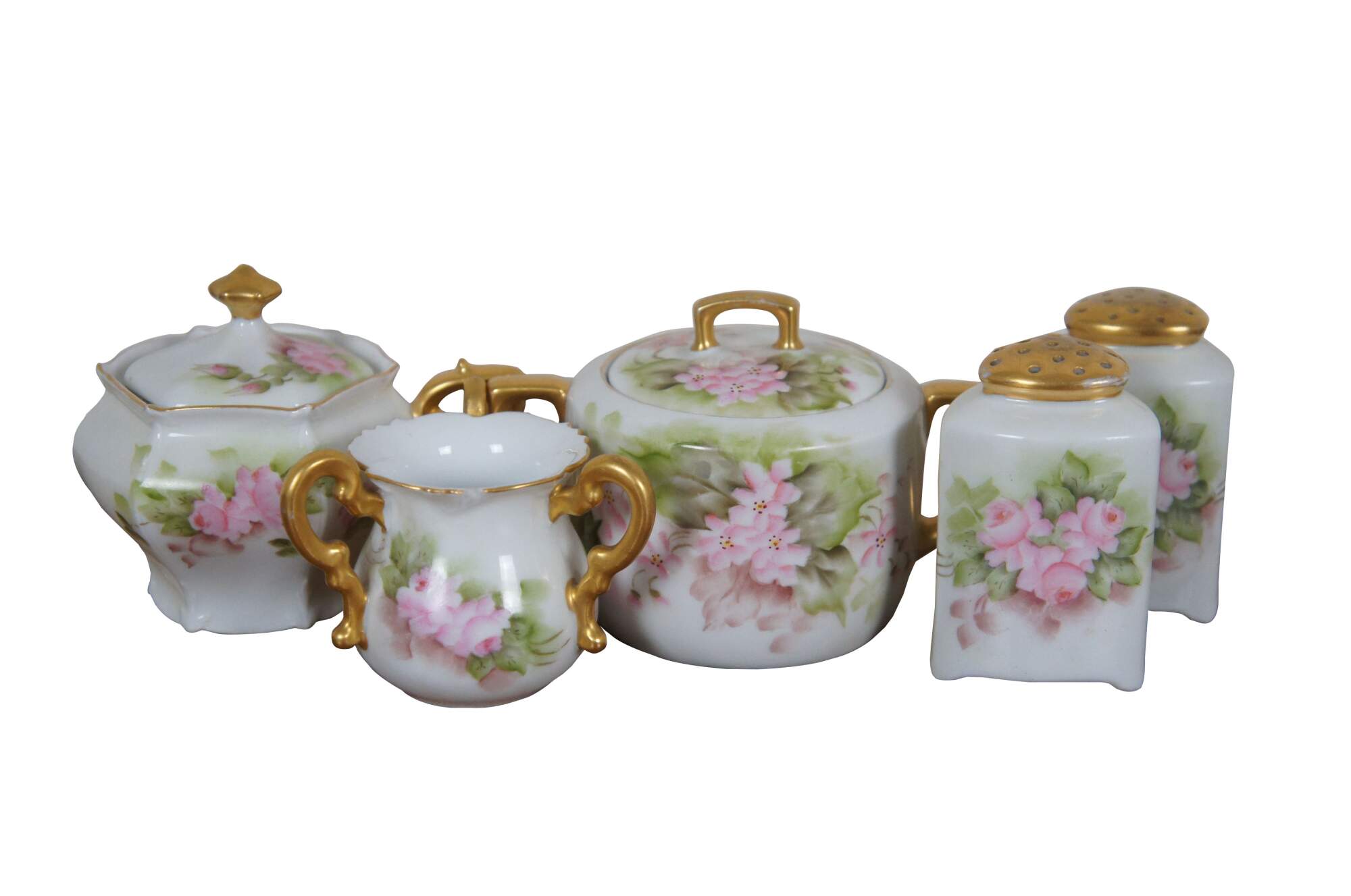
Shipping:
Free Shipping Included
Delivery:
Estimated 2-15 Business Days
Payments:
Credit Card, Check, Cash, PayPal, Apple Pay, Venmo
Returns:
30 Days 100% Money Back Guarantee, Buyer Pays Return Shipping
Description
Late 19th - early 20th century. Neat set of assorted tableware pieces, all decorated with hand painted pink flowers, green leaves, and gilded accents by F. Foljan. Double handled sugar bowl with lid by MZ Austria, incised number 1190/S (Mark used circa 1884-1909). Single handled sugar bowl with lid by RS Germany (aka RS Prussia; marked used circa 1914-WWII). Salt and pepper shakers by Oscar & Edgar Gutherz Royal Austria (mark used circa 1899-1918). Three handled toothpick holder with Vienna Austria export mark (mark used by various companies from 1885 tthrough the early 1900s).
"The Stara Role (Altrohlau) pottery works were established in 1810 by Benedict Haßlacher. The manufacture was bought by Augustin Novotny in 1824. Under his management employment rose to 100 workers. He also established three warehouses in Prague, Vienna and Pest. In 1836 Novotny started manufacturing porcelain. The factory production was constantly rising. In 1870 it employed 800 workers. The Stara Role (Altrohlau) pottery works were established in 1810 by Benedict Haßlacher. The manufacture was biught by Augustin Novotny in 1824. Under his management employment rose to 100 workers. He also established three warehouses in Prague, Vienna and Pest. In 1836 Novotny started manufacturing porcelain. The factory production was constantly rising. In 1870 it employed 800 workers. The MZ Austria marks were used by this porcelain factory since it was in 1884 bought on auction by Moritz Zdekauer Bank. The company exported products to North and South Americas and the Dutch colonies. In 1909 the firm was bought by C.M. Hutschenreuther and since then was used a MZ Altrolau mark. The Altrohlau Porcelain Factories operated till 1945, when it was nationalized. The company still operates in the Czech Republic under the name Starorolsky Porcelan Moritz Zdekauer in the town Stara Role near Karlovy Vary." (Source: The Old Stuff)
"RS Prussia was founded in 1896 by Reinhold Schlegelmilch, and later co-owned with his two sons, Ehrhard and Arnold. (Between 1861 and 1882 there were three porcelain factories started in the city of Suhl (in what is today Germany, then Prussia) by persons with the last name Schlegelmilch. Erdmann S. in 1861; Reinhold S. in 1869 and Carl S. in 1882. Until recently, it was thought all the Schlegelmilchs were family related. They were not.) From the time of founding up to 1892, it appears that little porcelain was exported to America from Reinhold's factory. Objects in several mold patterns used between 1889 and 1892 are known to be marked with the RS "Arrow" mark. Beginning 1893, US wholesale firms began to import larger quantities of china tableware from Europe, and almost all was from Reinhold's factory. Arnold took over an existing porcelain factory in Tillowitz in 1894, and continued to run it as part of the Reinhold Schlegelmilch enterprise until he died in 1934. From approximately 1895-1900 that the R. S. "Wing" trademark was used. Reinhold's products from the 1900-1905 period were noted as being among the best to be made in Europe. Unfortunately, public taste began to change about 1905. By 1910, simple shapes predominate in all catalogs, wholesale and retail, and Reinhold's products were largely replaced by china from both Japan and other European firms. Reinhold's products made after 1910 are frequently referred to as R. S. Germany, owing to a change in trademark. When the hostilities of WWI began in earnest, the Suhl factory was effectively shut down, owing to a lack of skilled labor. The manufacture of porcelain in Tillowitz continued through WWII. Although the plant survived undamaged, much of the equipment used to make porcelain was removed upon Russian occupation. Today, the factory still stands, but the major product is china dinnerware." (Source: RS Prussia / Real or Repro / Kovels)
"Oscar & Edgar Gutherz Royal Austria - Oscar Gutherz and Maximilian Marx had started a porcelain decorating business in Altrolau in 1884 with financial backing from Lazarus Straus & Sons, an American importer. Later the company began making porcelain. In 1898 Oscar’s brother, Edgar Gutherz, bought out Marx and joined Oscar in the business, which became known as the Oscar & Edgar Gutherz (O. & E.G.) Royal Austria factory. The factory exported decorated and undecorated porcelain. Many of the undecorated pieces were purchased by amateur painters in the United States. In 1918 the factory became part of OEPIAG, the Austrian Porcelain Industry." (Source: Kovels)
"Vienna Austria - This mark was used as a dedicated export mark owned by the Gräflich Thun'sche Porzellanfabrik Klösterle and had previously been used on items handled by three New York importers: PH Leonard had been the first in 1885 until his bankruptcy in 1898. He was succeeded by Bawo & Dotter who took his place for a short time before being replaced by Charles L. Dwenger, followed by Paul A. Straub around 1915. Logically nobody can nowadays say who actually imported specific items based on the mark alone." (Source: Porcelain Marks and More)
Condition
Good Overall - Gentle wear; no spoon
Dimensions
Largest Piece (Sugar Bowl) - 4.75" x 3.25" x 3.25" / Smallest Piece (Toothpick Holder) - 3" x 2.25" (Width x Depth x Height)